Horse Shoe Spread
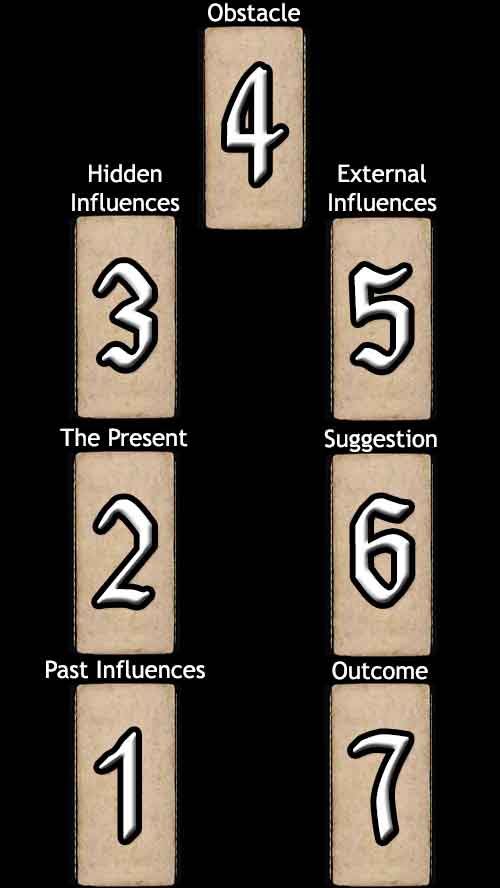
Difficulty: Easy
The Horse Shoe is a classic tarot spread. It is more advanced than the three-card reading, yet simpler than most other spreads. It is a versatile method that can be used for most queries, though there are other spreads which would go into more depth. Like the simple Past, Present, and Future spread, it contains these cards in positions #1, #2, and #7, but also has four other tarot cards that help the reader understand how to deal with the future better. The cards are to be read as follows:
- The Past: Past events affecting the question.
- The Present: The current state or approaching influence.
- Hidden Influences: Things the reader may not be aware of (or barely be aware of).
- Obstacles: This is the challenge: obstacles may be avoided or may have to be dealt with.
- External Influences: Attitudes and thoughts regarding people around the reader.
- Suggestions: Recommended course of action.
- Outcome: The result of following the suggestions.
Your Horse Shoe Reading
Obstacle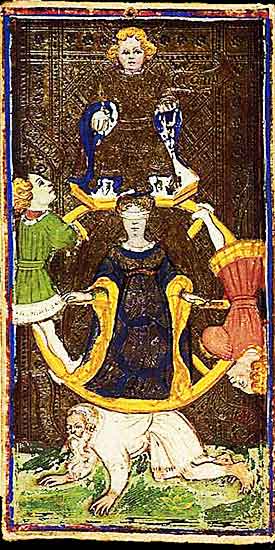 X – The Wheel of Fortune |
||
Hidden Influences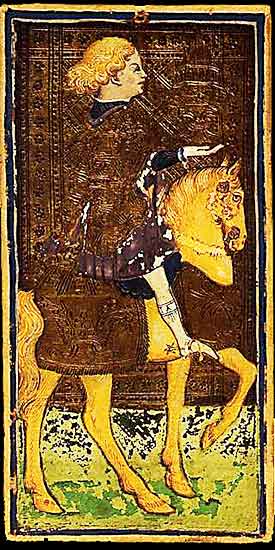 Knight of Cups |
External Influences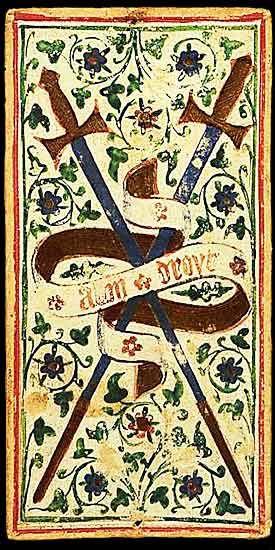 Two of Swords |
|
The Present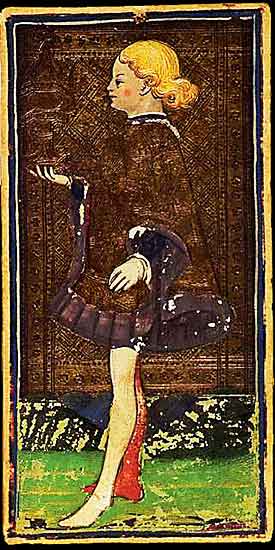 Knave of Cups |
Suggestion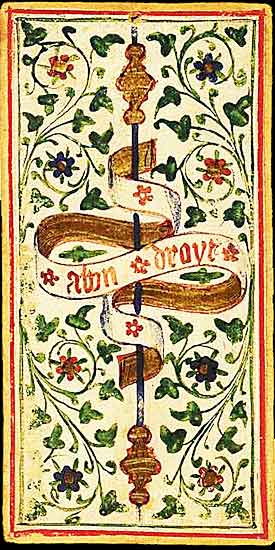 Ace of Staves |
|
The Past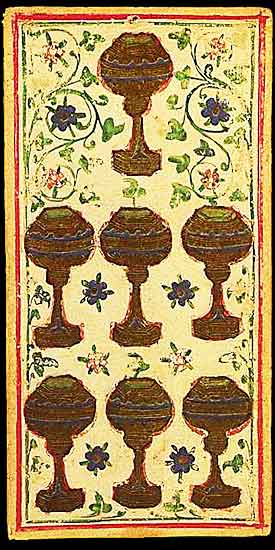 Seven of Cups |
The Outcome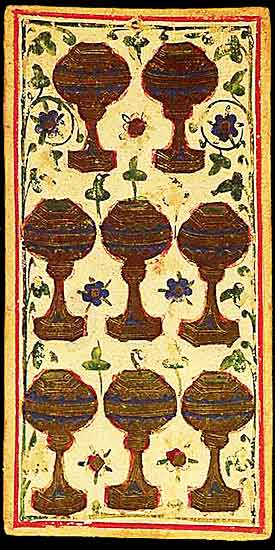 Eight of Cups |

The Past Card represents past events that are affecting the question.
Seven of Cups
The Seven of Cups represents choices, illusions, and dreams. It speaks to a time of possibility and decision-making, where many options are available, but it can also indicate confusion or a tendency to chase unattainable fantasies. This card invites you to assess your options.
Symbolism: The seven chalices, arranged asymmetrically, reflect the idea of varied possibilities, each with its own allure. The uneven arrangement symbolises the unpredictability of choice and the potential for distraction or confusion. The decoration of the chalices suggests each option carries its own emotional weight.
In Relationships: A period of many choices in your romantic life, but also a time to be cautious of unrealistic expectations or illusions. This card asks you to consider your options.
In Work: Multiple career paths or opportunities are available, but you may feel overwhelmed or unsure which one to pursue. The Seven of Cups advises introspection and discernment in your decision-making process.
Spiritually: A time to evaluate spiritual paths and opportunities. The Seven of Cups invites you to look beyond illusions and focus on what resonates with your soul.
When ill-dignified: Confusion, unrealistic expectations, or escapism. The Seven of Cups warns against being overwhelmed by too many choices or falling for empty promises.

The Present Card represents the current state or immediately approaching influence.
Knave of Cups
The Knave of Cups represents new emotional beginnings, curiosity, and intuition. It signifies the start of a new emotional journey, often marked by creativity, exploration, and open-heartedness.
Symbolism: The youthful figure holding a cup symbolises emotional openness and the willingness to explore new feelings and ideas. The vibrant green background contrasts with the figure's more muted robes, indicating that while this journey is new, it is rooted in emotional understanding.
In Relationships: A new romantic adventure, or the beginning of emotional exploration. This card signals fresh beginnings and open-hearted communication.
In Work: Creative opportunities or a new phase in your professional life. The Knave of Cups suggests following your intuition and embracing new emotional connections in your work.
Spiritually: A time of exploration and discovery. This card invites you to listen to your inner voice and follow your emotional intuition on your spiritual journey.
When ill-dignified: Emotional immaturity, unrealistic expectations, or a lack of direction. The Knave of Cups warns against rushing into things without considering the consequences.

Hidden Influences - Things that you may not be aware of, or barely be aware of.
Knight of Cups
The Knight of Cups represents emotional pursuit, idealism, and romanticism. It speaks to the pursuit of dreams, following one's heart, and embarking on emotional quests with passion and dedication.
Symbolism: The knight on horseback, holding a cup, exudes an energy of romantic idealism and emotional drive. The pale horse's steady gait and the knight's confident posture suggest a balance between passion and grace.
In Relationships: Pursuing romance with enthusiasm and idealism. The Knight of Cups suggests a time of emotional pursuit, whether the beginning of a romance or a passionate phase in an existing relationship.
In Work: A pursuit of creative or emotional fulfilment. This card represents following your heart and idealism in professional endeavours.
Spiritually: The quest for spiritual or emotional fulfilment. The Knight of Cups invites you to pursue your highest ideals and trust your intuition on your spiritual journey.
When ill-dignified: Impulsiveness, emotional highs and lows, or unrealistic expectations. The Knight of Cups warns against becoming too idealistic or pursuing unrealistic goals without grounding.

Obstacle - This is the challenge.
X – The Wheel of Fortune
The Wheel of Fortune signifies cycles, fate, and the ever-changing nature of life. It reminds us of the importance of adaptability and acceptance in the face of change.
Symbolism: Figures ascending and descending on the wheel represent the ups and downs of life. The patterns add richness to the composition, while the golden background underscores the divine and inevitable nature of change.
In Relationships: A turning point in relationships, whether for better or worse. The Wheel reminds us to embrace change.
In Work: Unexpected opportunities or setbacks. It advises adaptability and resilience in navigating shifting circumstances.
Spiritually: The Wheel teaches surrender to the cycles of life and faith in the greater plan of the universe.
When ill-dignified: Resistance to change, bad luck, or repeating cycles. It warns against clinging to the past or fearing the future.

External Influences - Attitudes about this situation from people around the querent.
Two of Swords
The Two of Swords represents a choice or decision that requires careful consideration. It speaks to moments of duality, indecision, or conflict where one must weigh their options. The card often appears when you are at a crossroads, and the need for mental balance is urgent.
Symbolism: The crossed swords signify a stalemate or a moment of pause, where no action is being taken yet, but the tension is palpable. The symmetrical composition emphasises balance and the need for equal consideration of both options before deciding.
In Relationships: A tough choice or an emotional conflict where you may avoid making a decision. The Two of Swords urges you to confront your emotions and choose the path that aligns with your desires.
In Work: Facing a critical decision in your professional life. The Two of Swords advises careful evaluation of all options before proceeding.
Spiritually: A moment of inner conflict or uncertainty in your path. This card calls for introspection and a balance between logic and intuition when navigating your spiritual journey.
When ill-dignified: Indecision, avoidance of the truth, or refusal to confront an issue. The Two of Swords suggests that procrastination or ignoring a situation will only prolong the discomfort.

Suggestion - The recommended course of action.
Ace of Staves
The Ace of Staves represents the spark of creation, vitality, and the raw energy of new beginnings. It embodies the potential of a seed, ready to sprout and grow into something magnificent. This is the card of inspiration, energy, and the initiation of new ventures.
Symbolism: The upright staff, with its textured bark and emerging sprout, symbolises the beginning of a new cycle, full of potential and promise. The plain tan background highlights the purity and simplicity of the elemental energy, inviting you to step forward with enthusiasm and confidence. The sprout near the base reminds you that all growth begins with a single step.
In Relationships: A new beginning or a burst of passion in your romantic life. The Ace invites fresh energy and the excitement of new connections or the rekindling of a relationship.
In Work: The birth of a new project or opportunity. The Ace of Staves signals that now is the time to seize your creative potential and pursue your ambitions.
Spiritually: A call to action. The Ace suggests you are on the verge of spiritual awakening or taking a new path. Trust your instincts and take the first step towards growth.
When ill-dignified: Lack of direction or motivation, possibly feeling uninspired. You may be hesitant to begin, caught in uncertainty or fear of failure.

The Outcome - What will happen if the suggestion is followed.
Eight of Cups
The Eight of Cups represents emotional departure, seeking something deeper, and the decision to walk away from what no longer serves you. It speaks to the need for introspection and self-discovery, as you leave behind the superficial in search of deeper meaning.
Symbolism: The eight chalices in staggered rows suggest a gradual departure or transition. The placement emphasises movement and emotional progression. The ornate details of the cups reflect the emotional investment required to make this decision.
In Relationships: A decision to move on from a relationship or emotional situation that no longer fulfils you. This card represents a quest for deeper connection or personal growth.
In Work: Leaving behind a job or situation that no longer aligns with your values or goals. The Eight of Cups suggests you are ready to pursue something more meaningful.
Spiritually: The journey towards deeper spiritual fulfilment. This card invites you to leave behind outdated beliefs or practices in search of greater understanding.
When ill-dignified: Running away from emotional problems or avoiding growth. The Eight of Cups warns against making impulsive decisions or leaving before you've fully processed emotions.